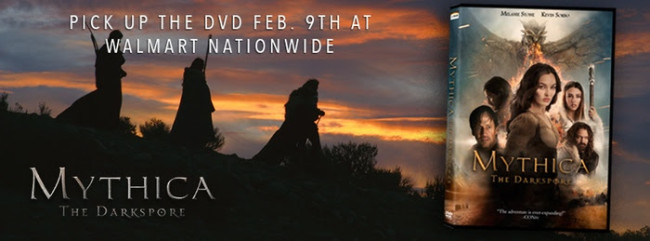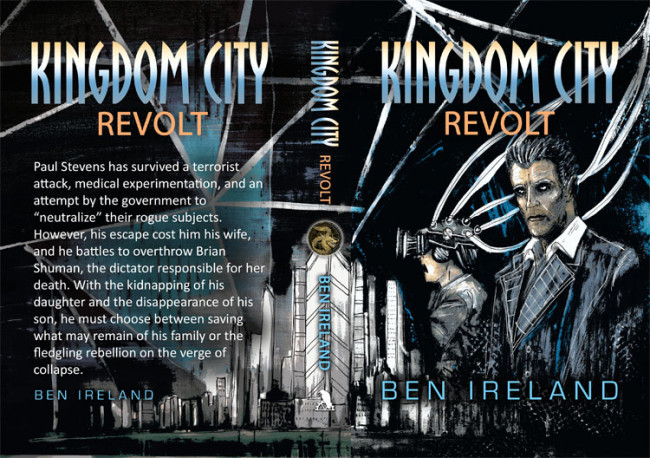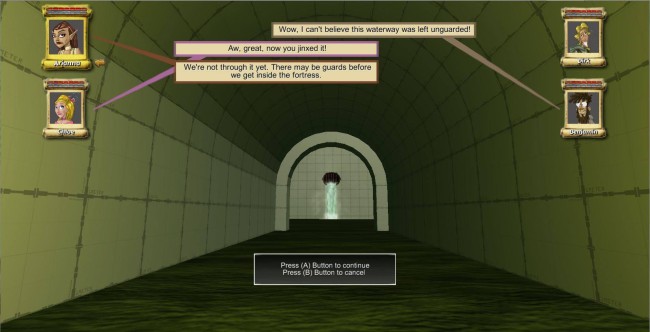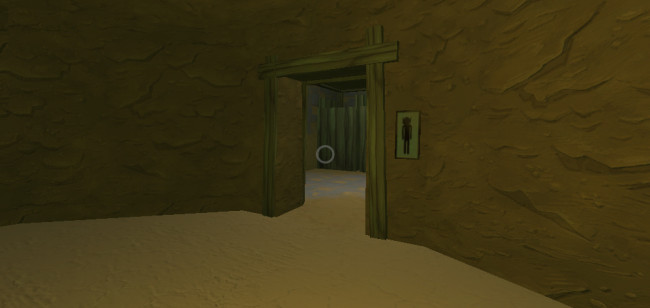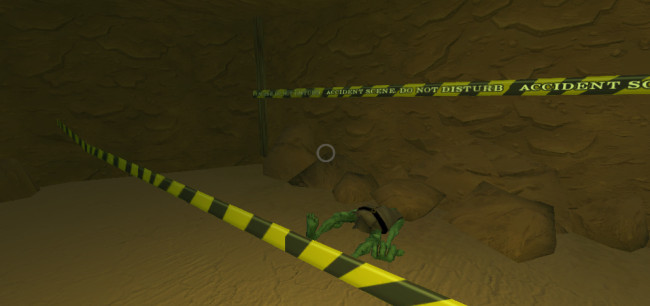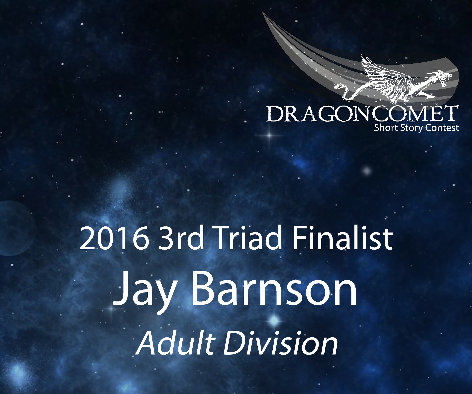Mythica 2: The Darkspore at WalMart in the U.S.
Posted by Rampant Coyote on February 10, 2016
Mythica 2: The Darkspore was released at WalMart throughout the United States yesterday. First-week sales are really important, so if you are at all inclined to check these movies out and haven’t already, and live in the U.S., now would be a great chance to snag a copy.
I’m a fan of the series (and that’s not true of all … or even most… Arrowstorm movies). The second movie was the weakest of the three released so far, but still quite enjoyable and critical to the overall story arc. It’s a little darker than the first movie, which is fun. And as my wife and daughter always remind me, it has a shirtless elf. If you still haven’t seen the first movie, Mythica: A Quest for Heroes, see that one first. I believe that one should also still be at WalMart.
Here’s a trailer for the whole series, although it only has scenes from the original three (and the effects weren’t finished):
I have worked with Kynan and Jason in the past, and would like to see them do well when their work deserves it. This does. Plus, the number of indie filmmakers both willing and able to pull off epic fantasy like this is pretty scarce, and I want to support that. Especially since their films seem to be going in generally upward trajectory in quality. So I’m helping spread the word here.
Finally, I really want to see the third movie in the stores. It’s the best of the three by far.
In related news – there are still a few days left for the Kickstarter for the fourth movie – Mythica 4: The Iron Crown. It is already fully funded, and at this point the series has been so successful that the crowdfunding really acts as more of a pre-order and audience involvement measure than anything else. Both of remaining Mythica movies have already been filmed. I’m crossing my fingers that the “upward trajectory” I mentioned holds true.
Anyway – enjoy!
Filed Under: Movies - Comments: 3 Comments to Read
Felipe Pepe tackles the nature of the RPG
Posted by Rampant Coyote on February 9, 2016
Elitist Old Farts unite! Or… uh, not. Why should we start now?
Felipe Pepe has composed a not-short article describing the nature of role-playing games, which largely breaks down into a discussion of why they are getting so difficult to define, and why they are proving difficult to… *cough* evolve.
Why Are RPGs So Difficult to Classify and Evolve?
Now, Felipe is an awesome guy and a true-blue old-school (elitist fart) kinda guy, a categorization I like to include myself within. We both harbor a love of walls of stats. He may be a bit more open-minded than me for what might be a good approach in an RPG. And he has less of a hang-up about using the word “evolve” with respect to RPGs.
But I do believe that his very title suggests the answer. Categorization limits. Evolution – at least in the way I see it – is a broadening of the category, a pushing beyond the old limits.
The challenge we have now in defining an RPG is trying to draw lines separating the games that we generally acknowledge as being RPGs from those that we don’t consider RPGs – and no matter how we draw the lines, things get included and excluded that we don’t think belong on that side of the line.
What we want is to draw just a few lines and then point out in a 90-degree arc and say, “From here out past the horizon and beyond is RPG. Go forth and bring back samples of the wondrous variety to be found here!” And instead, we mostly just cross-pollinate with the other genres and come out with more hybrids and make the lines blurrier and blurrier and necessitate more lines.
But the truth is – and Felipe knows this maybe better than I do – that this has always been the case. When we talk about “old-school RPGs” we tend to talk about a handful of favorites. We forget all the stillborn attempted evolutionary branches that failed for any number of reasons, many of which had nothing to do with the quality of their ideas. The truth is, there were tons of games back in the 80s that could have been the template for future RPGs that do not represent our concept of “classic, old-school RPG,” and a new, updated version of the title wouldn’t be considered an RPG today… but back then, we didn’t care.
Or maybe we did. I don’t remember. I have to browse through ancient back issues of Computer Gaming World to recall the discussions back then. Go back far enough, and even the name “RPG” or “Role-playing game” didn’t exist, for tabletop or computer games. You just had games that simulated some aspects that people enjoyed from playing Dungeons & Dragons or similar games. What aspects scratched that itch varied from designer to designer.
That’s really where we still are today. Except now, we’ve had some styles of gaming that have become the template. As Felipe says, for the new generation of RPG fans, it’s not about whether a game captures the feeling of playing D&D around a table anymore, it’s about whether it captures the feeling of playing Dragon Age or Mass Effect.
As Felipe says, computer RPGs are weird.
I love the RPG label, like I love the “indie” label, too much to give it up. The answer to things becoming difficult to classify isn’t to throw ones hands in the air and eliminate classification. If scientists did that, where would the scientific world be today, anyway? The issue is really one where the label gets appropriated by everything under the sun because it has some level of marketability, and thus all meaning and value gets trampled out of it. But it still serves a purpose. Just like saying “The American Northwest” can get kind fuzzy on the exact borders, it’s still pretty clear that Florida, New York, and Texas do not belong, but Washington and Oregon do. Just like we can argue over whether or not Pluto ought to be a planet.
So… yeah. We can argue over the fuzzy boundaries. There may be different aspects of games that scratch the RPG itch for us. All I can say is thank heavens for the indies (however you want to define “indie”) who are not (usually) following on the mainstream “evolutionary branch” of RPGs and are instead experimenting with the genre in different ways, mixing and matching the different aspects, borrowing from the past as well as the modern.
We’ve still got a long way to get to that horizon of possibility, and along the way we’re going to have a lot of stillborn ideas and epic failures and really weird experiments. We’re gonna have some games that people might call RPGs or roguelikes or roguelike-likes that we really don’t consider part of our own definition of the genre.
But that’s okay. Hopefully we’ll have a lot of fun along the way.
Filed Under: Design, Geek Life - Comments: 2 Comments to Read
A Fistful of New Books
Posted by Rampant Coyote on February 8, 2016
Okay, I guess you can’t REALLY make a fist if you are holding a book, but that’s besides the point. Here are some very new / upcoming books I wanted to tell ya’ll about, by or featuring friends of mine. And one that even includes my own humble contribution.
 First of all, there’s It Came From the Great Salt Lake, an anthology of horror stories set in Utah, authored by a whole bunch of friends and acquaintances, and edited by K. Scott Forman. These stories may be most interesting to folks who live or have lived in Utah, but they should be pretty fun stories across the board. The theme was intended to suggest all kinds of horrendous monster-movie / kaiju type of awfulness, but I understand the stories run the gamut. I’ll be grabbing myself a hard copy soon (today? I need to buy a copy from a friend…), but the book officially releases Thursday (Feb 11). The above link is just for the Kindle version, but it should be available in both paperback and Kindle versions very soon. The paperback will also be available at Life, the Universe, and Everything this week as well – with many of the authors on-hand for signings.
First of all, there’s It Came From the Great Salt Lake, an anthology of horror stories set in Utah, authored by a whole bunch of friends and acquaintances, and edited by K. Scott Forman. These stories may be most interesting to folks who live or have lived in Utah, but they should be pretty fun stories across the board. The theme was intended to suggest all kinds of horrendous monster-movie / kaiju type of awfulness, but I understand the stories run the gamut. I’ll be grabbing myself a hard copy soon (today? I need to buy a copy from a friend…), but the book officially releases Thursday (Feb 11). The above link is just for the Kindle version, but it should be available in both paperback and Kindle versions very soon. The paperback will also be available at Life, the Universe, and Everything this week as well – with many of the authors on-hand for signings.
Melissa McShane has been a friend since college. That makes for a longer-term friendship than I’d like to admit. She’s a gamer, a very skilled author, and also graciously assisted in proofreading texts and dialogue in Frayed Knights. If you come across any typos in that game, it’s all but guaranteed to be something I added late and thought I could just skip the editorial process. My bad. She’s good.
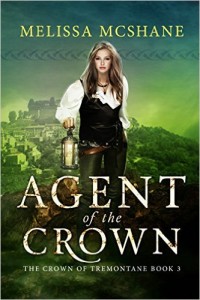 She is now a novelist and seems to be on fire. Hopefully not literally, only literarily. Her Crown of Tremontane series has really taken off, which excites us to no end. The series is heavy on the romance and politics, and follows different characters in each book. So you can probably get away with reading them out of order if you wanted to. The third book in the series, Agent of the Crown, should be released in a couple of weeks. The short version of the blurb: “Telaine North Hunter, Princess of Tremontane, is beautiful, spoiled, flirtatious, and the center of fashionable society throughout Tremontane. She’s also a spy.”
She is now a novelist and seems to be on fire. Hopefully not literally, only literarily. Her Crown of Tremontane series has really taken off, which excites us to no end. The series is heavy on the romance and politics, and follows different characters in each book. So you can probably get away with reading them out of order if you wanted to. The third book in the series, Agent of the Crown, should be released in a couple of weeks. The short version of the blurb: “Telaine North Hunter, Princess of Tremontane, is beautiful, spoiled, flirtatious, and the center of fashionable society throughout Tremontane. She’s also a spy.”
Her first two books in the series are Servant of the Crown and Rider of the Crown. There is also a novella in the series that bridges the gap between the first and third books, Exile of the Crown.
Next up is Kingdom City: Revolt, by Ben Ireland. It is the sequel to Kingdom City: Resurrection. Ben is a transplant to Utah from Australia (by way of Texas), and I got the chance to meet him as we manned the table together at Winter Faire in December. He’s also been in a couple of anthologies by Xchyler Publishing. We had the cover reveal back in October, and the book is available now.
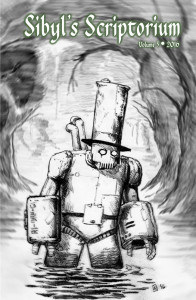 Next up is a book I’m personally very excited about…
Next up is a book I’m personally very excited about…
Sibyl’s Scriptorium Volume 3 is a collection of the winners and runners-up from the Æther Illustration Contest, DragonComet Short Story Contest, Odyssey Poetry Contest, and PhoenixMoon Graphic Novel Contest for 2016, sponsored by the Life, the Universe, and Everything symposium. My short story, “Best Wishes,” is a story about a genie dealing with the complications of granting wishes in the modern era, and will be included in the anthology. That’s all I know – we’ll find out the actual winners and where I placed on Thursday as well.
After the awards ceremony, it should be available for purchase from Amazon in paperback and in ebook format after that. The paperback will also be available directly from the Sibyl’s Scriptorium booth at Life, the Universe, and Everything this week after the awards ceremony Thursday night, and many of the authors and illustrators will be there for signings.
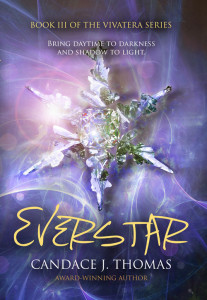 And finally – I’m friends with fellow Xchyler author Candace Thomas, a talented fantasy author and super-nice, friendly person. She’s been struggling with the final book of her Vivatera trilogy the whole time I’ve known her. And now – finally – it’s about ready to go out the door.
And finally – I’m friends with fellow Xchyler author Candace Thomas, a talented fantasy author and super-nice, friendly person. She’s been struggling with the final book of her Vivatera trilogy the whole time I’ve known her. And now – finally – it’s about ready to go out the door.
Everstar concludes the series, but you’ll probably want to start with Vivatera. 🙂 Final release date isn’t set yet, but it is probably just a few weeks away. Candace talks a little about her adventures releasing the novel and the trilogy in this blog post.
So there you go. More awesome reading to enjoy!
Filed Under: Books - Comments: 2 Comments to Read
Frayed Knights 2: Painting the White Boxes
Posted by Rampant Coyote on February 5, 2016
After a whole bunch of early, ugly, pre-pre-alpha screenshots from Frayed Knights: The Skull of S’makh-Daon found their way into reviews of the final game, I’ve been reluctant to show Work In Progress screens for Frayed Knights 2: The Khan of Wrath. Which totally sucks, because these are the kinds of things that I got some useful feedback from people during the development of the first game. I could post a big “WORK IN PROGRESS” stamp across the middle (they’ll cut out anything that’s along the edges), but that would kind of defeat the purpose.
Anyway, today’s small update is showing just how dependent I am on the artists. Nick, Kevin, and Taylor have all worked on the game making it look… like a game, instead of a programmer’s boxy proof-of-concept.
How we’ve been doing things is that I have been “white-boxing” the levels… making levels of the main geometry and principle scripted events, then handing them over to the artists to make them look good. While they are doing that, I can still work on the level, just so long as I don’t make any changes to the principle geometry.That way we can work concurrently on the same levels.
In theory, at least. In practice… we’ve had to work out some kinks. Still are. A lot of it is in communication, and that’s stuff I need to work on more. But things are coming along, limited by such constraints as family, day jobs, and school. Frickin’ priorities.
So here’s an example of a whiteboxed area that I’ve done:
And here’s the nearby area after Nick Lives has taken a pass at it:
This is still not complete (especially with lighting / water), but it’s a pretty good before / after view.
Another advantage of working with these guys is that they can add their own creativity to these areas, and I’ve found that creativity can magnify itself in small teams. They have ideas, I have ideas, and we bounce them off each other and get better ideas. All of us abhor the idea of “filler” content, in spite of the fact that these dungeons are HUGE on the average (our average size is about equal to the largest dungeons in FK1. We’ve only got a couple of fairly petite levels of only a dozen rooms or so), and so we all like coming up with ideas to make the visuals, the gameplay, or both stand out to keep things interesting all the way through.
So we get some more of Nick’s twisted imagination, off in the “back rooms”:
I guess you could say we’ve been working so quickly that some safety procedures have been bypassed, and some accidents have occurred. Tragic:
This is definitely a fun stage of development. It feels like the game is growing in HUGE steps now, which feels awesome. We’ve got a major milestone coming up at the first of June – the Salt Lake Gaming Con. While the game won’t be completed by then, we’re pushing to get as much done as possible by then so we can show off more of the game to people. That may be only non-interactively… RPGs are tough to show at a convention when you may have only a few seconds to a few minutes of someone’s attention as they are walking along.
It’s gonna be a busy, busy four months.
(Incidentally, the tool I’m using for white-boxing the levels is ProBuilder, which is a pretty awesome tool for Unity).
Filed Under: Frayed Knights - Comments: 6 Comments to Read
Upcoming: Life, The Universe, and Everything and Sibyl’s Scriptorium
Posted by Rampant Coyote on February 4, 2016
I’m a finalist for Sibyl’s Scriptorium’s annual DragonComet writing competition. The awards will be presented at this year’s Life, The Universe, and Everything Symposium held in Provo, Utah next week (February 11-13). Regardless of how I place, my story (“Best Wishes”) will be published in the anthology. So… exciting times! I will be at the event on Thursday evening, and I’ll be at the Xchyler publishing table(s) part of the time signing books, and I’ll be participating in the “Mass Book Signing” event signing… pretty much anything you want me to sign, including copies of this new anthology.
I don’t know why you’d want me to sign anything… it’ll probably drop the resell value… but hey, I’m happy to do it. Unless it’s a legal document. I’m not gonna fall for that one again… 😉
While Utah now has Comic Con and some similar conventions, LTUE is a different sort of experience. At least it was the last time I went, and so I’ve been told recently. It’s more of an academic symposium, so the events and activities are a bit more focused on discussion, academic presentations, networking, and professional development than the typical “fan” oriented experiences like Comic Con. But that’s not to say it doesn’t have its share of fun and games – there’s plenty, from Magic the Gathering tournaments to Cosplay “how to” panels to filking. You can check out the schedule here.
And there’ll be lots and lots of authors, including Kevin J. Anderson, Shannon Hale, Brandon Sanderson, David Farland, Mary Robinette Kowal, Howard Taylor, Dan Wells, Larry Correia, D J Butler, Rebecca Moesta, Michaelbrent Collings, and… hey, Jay and Julie Barnson! 🙂 And scads more.
We’re gonna have a good time! If you can make it, be sure and catch me and say hi!
Filed Under: Books, Events - Comments: 2 Comments to Read
Released! Aveyond 4: Shadow of the Mist
Posted by Rampant Coyote on February 3, 2016
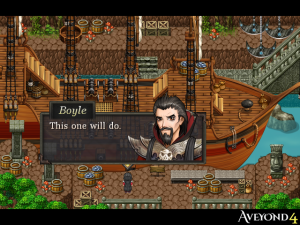 It’s been a while since we’ve had a new Aveyond game. Aveyond 4: Shadow of the Mist was just released, and it’s been in development for quite a while. It was created in conjunction with John Wizard games (maker of the Dawn’s Light and Lilly & Sasha series). Both Amaranth and John Wizard have a reputation for making quality jRPG-style games, which counts for a lot when there’s so much low-quality stuff (especially RPGMaker titles) making it hard to find the gems.
It’s been a while since we’ve had a new Aveyond game. Aveyond 4: Shadow of the Mist was just released, and it’s been in development for quite a while. It was created in conjunction with John Wizard games (maker of the Dawn’s Light and Lilly & Sasha series). Both Amaranth and John Wizard have a reputation for making quality jRPG-style games, which counts for a lot when there’s so much low-quality stuff (especially RPGMaker titles) making it hard to find the gems.
The blurb: “Boyle Wolfbane wanted to rule the world. He failed. Miserably. Forced into retirement early, Boyle now spends his days arguing with haunted trees and scaring off the occasional knight. At least he still has Fang, his loyal storm wolf. Things could be worse. He could have been born a hero.”
I’m looking forward to playing this one. It’s definitely available for Windows… I’m not sure about other platforms. (The newest version of RPG Maker has broader platform support, but this one has been in development for a while and may still be on the previous version).
You can download the demo and get trying it out immediately.
Otherwise, you can check it out here:
Filed Under: Game Announcements - Comments: 3 Comments to Read
What’s Clogging the Crap-Filters This Year?
Posted by Rampant Coyote on February 2, 2016
I picked up a game on Steam over the weekend that billed itself as a 3D roguelike. I won’t name the game. I try to avoid dumping on indie games here, even when they really deserve it.
And man, this game deserves it.
What makes the game terrible? It came across as a Game Jam project crammed with nothing but off-the-shelf assets, thrown together with minimal design, and with half the features missing and the rest implemented poorly or broken. There are big gaping holes where features were obviously intended, yet it doesn’t bear an “early access” label. Instead, it’s being pawned off as a very low-priced complete game.
Which, I guess, if you have zero pride and don’t care about games or your customers, makes perfect economic sense as a developer in this day and age. Throw something together in a few days in an already stable engine, dump it on the market for pennies, and repeat. A good came takes 100x longer to make and will only sell for 5x to 10x of your price. You can generate lots of sales by being super-cheap and then running sales and throwing your game into bundles.
This may be the reality of the “race to the bottom” and the “indiepocalypse.” The filters are clogged with crap, so you can either make the risky move of taking the time and effort and money to make sure your title stands out above its peers and gets noticed by enough people to hit critical mass… or you simply dump more crap into the pipeline figuring some of it’s going to make it through by sheer overwhelming numbers.
And of course, with the Internet being the way it is, the game that aspires to greatness but falls somewhat short is entitled to only slightly less scathing criticism than the flaming turd dumped into the marketplace. Although this may be entirely due to the fact that it is almost completely ignored.
Such is our modern era of video games, I guess. It’s not new. I’ve talked about it before. And it’s not even unique to video games.
Can anything be done?!?!?!?
At this point, all I can ask is that people please, please try to be kinder or at least attentive to the lesser, forgotten, flawed gems. Review them. Talk about them. Recommend them, if you feel so inclined — with whatever caveats or reservations you feel necessary to make. Help them get noticed, so that the really lowly crap will sink to the bottom.
Filed Under: Biz, Indie Evangelism - Comments: 6 Comments to Read
Game Canceled After Partners Allegedly Blew Kickstarter Funds on Liquor, Bars, and Strippers
Posted by Rampant Coyote on February 1, 2016
 This is both awesome and terrible, but leans more on the side of terrible:
This is both awesome and terrible, but leans more on the side of terrible:
Ant Simulator Canceled After Devs Spend Kickstarter Money on ‘Booze and Strippers’
Technically, it wasn’t the game that was funded by Kickstarter funds, but a tutorial series (unless there was another crowdfunding campaign that I missed). But the cash from crowdfunding plus investment money for making a commercial version of Ant Simulator was apparently squandered, causing the programmer and creative director Eric Tereshinski to leave the LLC he created and call it quits and resign.
The game was looking pretty sharp, too. Something cool and different, at least. A vast improvement over the original Ludum Dare project, but a good look into what it takes to turn a 48-hour prototype into something with of commercial quality.
Eric Tereshinski is looking to personally refund the money for pre-orders of the game, which is a stand-up thing to do, but … how? And was the pre-order money part of the reported funds that were misused? Assuming so and assuming his claims are legitimate, it’s going to be tough going.
I could make one of my usual warnings about being careful who you fund in a Kickstarter, but in this case, other than a bit of confusion about where the money was really going, it wasn’t such an unknown entity. The guy had done tutorial videos before, and so he was a known quantity. What exactly his partners were bringing into the mix was a little less clear, and maybe that could have been a warning sign.
But really, regardless of what may have happened here, I take this is more of a warning about business partners, and how to run a business, I guess. In any case, they were long-term friends who went into business together, and reportedly two of the partners raided the till to party – supposedly in a contractually valid way, but they still behind the back of the third partner (and the public face of the company, and the one who the company was kind of built around). ANY potential entrepreneur is terrified by scenarios like this one. Including me.
Of course, this is just one side of the story. But it’s easy enough to imagine.
UPDATE: Another side of the story – the partners speak up. Wherever the truth lay, it’s clear there was a dysfunctional business relationship going on there. Ick.
Filed Under: Biz - Comments: 2 Comments to Read
The Indiepocalypse Continues: Arcen’s Story
Posted by Rampant Coyote on January 29, 2016
So Arcen has a critical success that is a commercial flop, for various reasons, and this small indie team is going to have to be gutted as a result.
I was talking to a friend on Facebook today, and I mentioned that when the market gets like this, when supply totally outgrows demand by such a huge factor, suppliers / makers start slitting their own throats to earn their customers, and the market begins to perceive this as normal. And so you get comments like the ones in the PC Gamer article about this.
While many of them are behaving like asses, many of them (even the jerks) have a point. I mean, at this point, I’ve got way more games than I’ve got time to play them, so I really need to be sold on a game to consider forking out even a little money for it. But I still get new ones – especially indie games – that interest me because I understand the dev side of things too, and realize that I can’t demand that a developer spend a million dollars to make me happy enough to give them $15. That’s silly.
But that’s also the market we’re in now. Until the “Indiepocalypse” runs its full course, it’ll be the “new normal.” Maybe one day people will say, “Remember back in the mid 2010s when companies were falling over backwards and running at huge losses to make us more games than we could possibly play, and selling them to us for only $5? Good times, good times…”
The gold rush is playing out like it always has. As a gamer, enjoy it. As a developer… well, decide what you really want to do. If it’s to make games, I guess the answer is to buckle down and ride out the storm. It won’t be over quickly. And it won’t ever be easy.
Filed Under: Biz - Comments: 5 Comments to Read
Computer Beats Go Champion, Shaking the AI World
Posted by Rampant Coyote on January 28, 2016
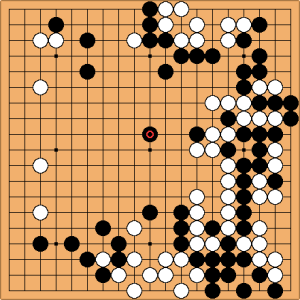 The first game I ever played over the Internet (as opposed to a dial-up BBS, waaaay back in the day) was the game of Go. I was learning to play the game as part of a class in AI. Our big project for the semester was to create a competitive Go-playing program. So besides playing other students, I tried this Go server that used Telnet.
The first game I ever played over the Internet (as opposed to a dial-up BBS, waaaay back in the day) was the game of Go. I was learning to play the game as part of a class in AI. Our big project for the semester was to create a competitive Go-playing program. So besides playing other students, I tried this Go server that used Telnet.
It was late at night, and I was playing someone from Korea. Fortunately, he spoke (typed) decent English. We chatted as we played. He knew I was a beginner – he considered himself a beginner, too, but he was FAR more experienced than me. That’s Asia for you. Anyway, he kindly warned me without giving me details that I was in trouble and leaving myself open to his attack, but I couldn’t figure out what he meant. We both saw the same board, but I couldn’t tell what I was doing wrong. I was playing an efficient game, I thought, and I’d been one of the best players in my class.
Finally, he made the attack he’d been warning me about. It was devastating. My groups weren’t as safe as I thought they were, and I found myself without any kind of decent plan to or option. The game was over within a dozen or so moves after that. I thanked him for the game, he offered encouragement, and I was able to fix some weaknesses in my play. Just a few. I still have tons. I still suck at Go.
***
The problem with my game was in part a problem with developing AI to play Go. The rules of play are deceptively simple, leaving the complexity in actually playing the game. The possibility space is too large for a brute-force search of probable moves, although with my program for the class competition, I did incorporate some of that. Perhaps more importantly, the challenge is understanding what’s really happening on the board, and recognizing all the relationships between the stones.
That’s really the problem with all of AI – coming up with a way to represent and evaluate the data. Sure, the AI can see the Go Board… 19×19 spaces with 3 possible states for each spot (empty, black stone, or white stone) is no big deal. Playing the game is again no big deal – the rules are easier than those of Chess. But one of the challenges in Go is that even calculating the score can be a little tricky, even for humans. Beginners, in particular, may get into disagreements over the score and have to play things out after the game is over to be certain of the score in a close game.
That’s all stuff the AI has to understand on one level or another The key to playing Go is to understand those relationships. There’s no single good way to do this. For our projects in my AI class, the sample concepts that we had to work with included weighting of squares (it’s easier to find safety and to control space working near the corners and edges than in the center), armies (groups of connected stones), influence, liberties, and detecting “eyes” (liberties that are unassailable by the opponent – if a group has two eyes, it’s impossible to capture). These were all relatively complex topics on their own, and prone to errors. Then trying to get the AI to work with all of these in some sensible format was another hurdle. And, finally, these were only the beginning.
I got a little obsessed over this when I was working on it. I’d walk to school obsessing over influence maps and better ways of recognizing patterns on the board. But even so, I realized that for truly high-level play, there was more to it than a fallible human would have to devise and explain. At some point, the machines would have to use more generalized pattern recognition and machine learning to master the game. While I always thought it was possible, it also always seemed distant. Even as modern Go-playing programs could kick my butt with ease, there was still a long way to go.
***
This week, a Google-sponsored system called AlphaGo defeated European champion Fan Hui. Not just defeated, but shut him out, 5-0. While he’s not on the level of the Asian masters, this is definitely a big deal, and not just within the limited field of one of the most popular – and most ancient – actively played games.
Chess was a different animal, solved by a very different strategy. The fundamental approach (albeit enhanced by several other methods) was a search of a problem space, plus pruning tricks to make it more efficient. Even so, it took decades from the point at where it was first capable of beating normal human to the point at which Deep Blue was able to truly go toe-to-toe against Gary Kasparov. Chess was easier to define in terms of problem space, which in AI is half the problem. After that, it was all optimization. That same AI approach has numerous real-world uses that have been applied for decades in various areas, particularly expert systems, but its application is limited to areas well well-defined and limited problem spaces.
AlphaGo – and the Jeopardy-winning Watson – represent something else. These games represent much wider areas of applicability in the real world. As my AI professor explained it, Chess is a game of tactics representing a single battle. Go is a game of an entire war… and not just war, a coexistence. While you can’t just reprogram AlphaGo to solve world peace or something like that, it does represent a breakthrough in machine learning and pattern recognition that has innumerable real-world applications.
I was getting my butt whupped by Chess programs since the first one I played, so it wasn’t like I felt any loss when Deep Blue first defeated Kasparov. I suck enough at Go that I have been getting beat by Go programs for a long time. I’m not one who takes seriously the concerns of machine consciousness or the coming of SkyNet. I’m not super-worried about machines thinking for us. They are tools, just like levers and backhoes, which magnify human capability. In this case, we get tools to help our brains and not just our muscles. Like a calculator. Only this time, we may end up with a more powerful version of Siri. Somewhere down the road.
But this week – even though there are more tournaments to go – I feel like that puzzle I obsessed over back in college has finally been solved.
That seems pretty cool.
Filed Under: General - Comments: 8 Comments to Read
Atari Vault Coming to Steam
Posted by Rampant Coyote on January 27, 2016
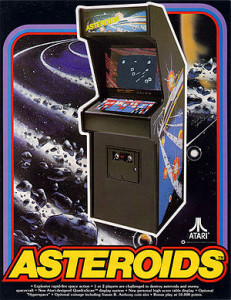 “Atari Vault” is coming to Steam. With, like, global Steam leaderboards for Atari games. Which is cool.
“Atari Vault” is coming to Steam. With, like, global Steam leaderboards for Atari games. Which is cool.
What’s unclear is exactly what original format these games will be – arcade, the 2600, the 5200, or even some of the Atari PC / Windows games? The ones mentioned by name – Centipede, Asteroids, Tempest, Missile Command, and Warlords – had several incarnations, including arcade, console ports, and remakes. (In fact, I recently played an Web version of Asteroids on Atari’s own site which is… um…. terrible.)
Maybe this is a chance for MAME players to finally go legit? I can hope…
These are supposed to be updated with new multiplayer options, Steam leaderboards, and Steam Controller support. The word on the press release is that the Steam Controller offers much more precise control. We’ll see. It’s supposed to be demoed at PAX South at the end of the week.
But hey… if I could add some arcade-game wishlist items, how about… RoadBlasters? Space Duel (really an Asteroids sequel)?
Filed Under: Retro - Comments: Comments are off for this article
The Strange RPG Keeps Getting Stranger: Five Nights at Freddy’s World Released, Removed from Steam
Posted by Rampant Coyote on January 26, 2016
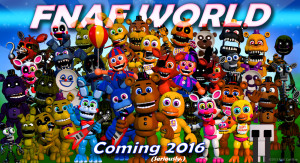 Five Nights at Freddy’s is a very popular jump-scare horror game series by indie developer Scott Cawthon. I’ve played the first one. I was amused. My kids, however… my kids loved it. They and their friends didn’t want to play it, mind you. Maybe because it was too scary? No, they wanted to watch other people play it. Especially if said people got scared. Watching other people get scared is more fun than getting scared, I guess.
Five Nights at Freddy’s is a very popular jump-scare horror game series by indie developer Scott Cawthon. I’ve played the first one. I was amused. My kids, however… my kids loved it. They and their friends didn’t want to play it, mind you. Maybe because it was too scary? No, they wanted to watch other people play it. Especially if said people got scared. Watching other people get scared is more fun than getting scared, I guess.
The decision to turn move the horror IP to a lighter, cute jRPG style game was a little inexplicable. Five Nights at Freddy’s World was announced many months ago, and many people thought it was a joke or something. I mean, REALLY?
So THEN, it appears somewhat ahead of schedule on Steam. I thought, “Wow, that was fast!” And it was. It was actually ahead of his scheduled release. I intended to pick it up soon and check it out, just to say I’d played it and to gather a little bit of first-hand experience with what was certainly going to prove an… unusual indie RPG. I understand it actually is a little bit of a joke… a parody of the horror series, played for humor, but a real RPG nonetheless. My interest is natural.
I may have to wait a little longer. Cawthon has pulled the game from Steam, plans on refunding everyone who bought the game, and has basically taken it back into the workshop after complaints that critical RPG features were missing. Have I mentioned that making an RPG is challenging and time consuming before? Well, it is. Key information was missing, the rules and systems were apparently pretty opaque, and the writing was said to be inconsistent. In spite of all this, it garnered pretty good reviews.
Cawthon plans on fixing many of the gameplay issues and then re-releasing it for free in a few weeks. However long it takes to fix the issues.
His full statement is as follows:
Hi everyone, I wanted to make a post about the fate of FNaF World. Even though the game had a “Very Positive” rating with 87%, I was not satisfied with the reviews and ratings it was getting.
For that reason, I’ve decided to remove the game from Steam. I’ve also asked Valve to make it so that the game can be refunded regardless of the amount of the time it has been owned, meaning that anyone can get a refund at any time. It may take them a while to set that up, but it will be in place soon.
I’m still going to work on FNaF World and polish it up. I’m busy creating a fully 3D overworld for the game. When I’m ready to update the game, I will replace the demo currently on GameJolt with the full game. From this point forward, the game will always be free.
I appreciate your support, and I encourage you all to refund your Steam game (even if you enjoyed the game), and download the new version when it becomes available on GameJolt. 🙂
It’s a strange story, keeps getting stranger.
Still, I wish him luck. And I look forward to checking out the game, eventually.
And yeah… a reminder: making RPGs is challenging and time-consuming.
Filed Under: Biz, Indie Horror Games - Comments: 2 Comments to Read
Design: Why RPGs Shouldn’t Be Too Short
Posted by Rampant Coyote on January 25, 2016
 Several years ago I wrote an article musing over the possibility of “short-form” RPGs… like the equivalent of a short story vs. a novel. In retrospect, I think I understand the reasons why. Live and learn.
Several years ago I wrote an article musing over the possibility of “short-form” RPGs… like the equivalent of a short story vs. a novel. In retrospect, I think I understand the reasons why. Live and learn.
In general, RPGs are about character development. This happens on the mechanical level, as you level up from a chew toy to a legendary hero. But it should also happen on a narrative level as the character grows and progresses to become an active force and agent of change in his world, hopefully accruing something that – in a computer RPG – might be the equivalent of a personality and history, at least in the mind of the player.
This sort of thing takes development, and is hard to present in a game that is over in 5 or 6 hours. But there’s more to it than that.
One of the most compelling properties of RPGs – the elements appropriated in other genres – is the idea of accumulating stuff: skills, equipment, even houses. That’s all fun, but it only makes sense within the context of the world. When you’ve completed Skyrim, there’s no longer any point to that house you’ve built and painstakingly decorated. Perhaps that is an advantage of the MMOs – the persistent world is always there if you want to pay it a visit.
There’s a feeling of dissatisfaction when the game comes to an end and all the really cool stuff you’ve been acquiring and building suddenly becomes meaningless. I suppose it’s analogous to death, and you need a really satisfying conclusion to make up for the fact that your Armor of Uber Awesomeness will never be used again, and there’s nothing left for you to do with your crazy powers of Sub-Atomic Particle Awareness. We need a game that lasts long enough so we can feel we’ve gotten a good use out of these toys. That’s also a strong suggestion that designers shouldn’t save the best for the last minute.
Of course, in saying all this, I’m ignoring the roguelikes. Many of those games only last minutes (and end in disaster), and encapsulate the basic RPG experience pretty well, but emphasize replayability. This doesn’t address the possibilities of the (very rare) episodic RPGs, either, which have character and world persistence broken up into smaller chunks.
Things vary by game experience and by audience, so I don’t think there’s a hard-and-fast minimum time rule that can be applied. But in general, our relationship with our character(s) in an RPG has to last long enough to enjoy both the mechanical and narrative character growth. In a rich RPG system (and most are, these days), this will take a while.
(Image from the movie Scott Pilgrim vs. The World)
Filed Under: Design - Comments: 18 Comments to Read
InSomnia RPG is Going Back to the Crowdfunding Well
Posted by Rampant Coyote on January 22, 2016
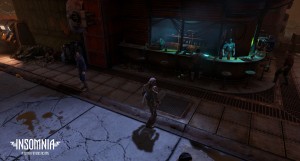 This is both unsurprising and disappointing. InSomnia – now described as a “retro-futuristic” RPG (previously a “dieselpunk” RPG… I’m not sure if that’s a new direction or simply a way to describe it to people who don’t know what dieselpunk is) – is running out of money after a quarter-million was spent in development. They announced yesterday that they are launching another Kickstarter campaign to get additional crowdfunding.
This is both unsurprising and disappointing. InSomnia – now described as a “retro-futuristic” RPG (previously a “dieselpunk” RPG… I’m not sure if that’s a new direction or simply a way to describe it to people who don’t know what dieselpunk is) – is running out of money after a quarter-million was spent in development. They announced yesterday that they are launching another Kickstarter campaign to get additional crowdfunding.
Most of the nearly quarter-million dollars they report spending was from their own pockets, not the original Kickstater funding, so it’s not like they weren’t committed. They had skin in the game. But their design was really ambitious. Originally, before a previous Kickstarter failed, the game was billed as an MMO. More recently, they changed engines from Ogre3D to Unreal, an action that necessitated rebuilding their assets, and more than doubled their projections for game length.
At least they are planning on releasing a new demo to demonstrate their progress before the new campaign launches. I haven’t played the old one. I want to believe, but… well. I hope they make it, and actually release this year. But I cannot say I’m overwhelmed with confidence. Ambition and talent is great, and I want to support that, but experience counts for a lot more.
Filed Under: News - Comments: Comments are off for this article
Mystery Game Sales: Cool Discovery Tool, or Sign of the Indiepocalypse?
Posted by Rampant Coyote on January 21, 2016
Lately, it seems that “mystery games” are becoming more popular around popular indie game distribution sites. Pay your money now, find out what you get later. There are a lot of examples, but I’ll point out some big ones:
Humble Bundle is doing this with a subscription service. Random games every month.
GOG.COM has done this as part of their sales.
Green Man Gaming is doing this.
This isn’t really new. It’s actually older than games. But this isn’t done with big-ticket items. It happens when things have become dirt-cheap and commoditized. Oftentimes mystery ‘grab bags’ are offered from a seller which is mostly made up from crap that doesn’t sell, plus some carefully placed decent products to make the gamble sound interesting.
Part of me says, “This is a sign that the Indiepocalypse is in full swing.” People aren’t paying for quality at this point. They don’t care about the titles. They aren’t paying for something great. A game or three, any game, who cares what they are? It’s so cheap it doesn’t matter. If they are lucky, they’ll get something that amuses them for a few minutes. Of course, even though they may know the titles in advance, this description pretty much applies to your average game bundle as well.
Games have become commodities. Utterly replaceable. Like corn chips.
BUT…
There is a flip side (Boy, is that a dated reference for all but the most die-hard audiophiles, or what?). Maybe a multiple sides.
For one thing: This isn’t necessarily a cause so much as a symptom. It can be a way to adapt to the “Indiepocalypse” – which may really just be “the new normal.” As one example: Customers are increasingly getting used to the “real” price of a game being its lowest sale price. If a game sells for $20 on Steam but I’ve seen it on sale for 75% off, in my mind it becomes a $5 game. Maybe that was a one-time event, but I’m probably going to ignore a 30% off or even 50% off sale for a while on that one. Being a “mystery game” means that you’ve never technically offered it at that discount. It was $5 for a mystery game that happened to be your game that month. It’s a little bit of a way to get the best of both worlds.
It behooves distributors not to use “mystery games” as dumping grounds for worthless games that can’t be sold otherwise. Customers will quickly wise up and treat it as such if that’s the case. So… in some ways a “mystery game” may have to be a decent, quality game at least as often as not, maybe not in a favored genre or maybe something that has trouble getting noticed, but a “mystery game” may be considered as a badge of quality. It has to be an incentive.
And as a customer, assuming the former paragraph is true, this can be a really good thing. Assuming said customer is willing to give these games a chance, they may discover some really great games that for some reason or another were easily overlooked and they might never have discovered otherwise.
So… cool discovery tool or sign of the “Indiepocalypse?” Maybe a little bit of both.
But even within indie games, we’ve seen stuff like this in the casual space, just before the bottom kinda fell out there. And then what happened? Well, the bottom fell out, there was a big consolidation, and a lot of companies went under. And then… well, casual games are still here. It’s not the frenzy it once was, but they are still doing their thing.
As it will be with the rest of indie gaming.
Filed Under: Biz - Comments: 4 Comments to Read
Book Impressions: Stay Awhile And Listen
Posted by Rampant Coyote on January 20, 2016
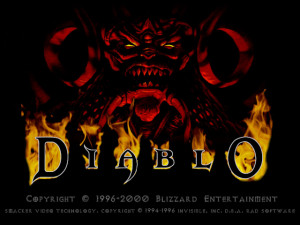 What a great age we live in! As a kid I was lucky to find a handful of books that would talk about my niche hobby, video games. Today? Not only are there plenty, but there are books devoted just to individual games. I’m not talking strategy guides or licensed novels about the really popular ones, but just books about the game. In this case, I’m talking about Stay Awhile and Listen: How Two Blizzards Unleashed Diablo and Forged a Video-Game Empire, by David L. Craddock. He’s also the author of Dungeon Hacks, which I covered several weeks ago, which is all about the history of roguelikes.
What a great age we live in! As a kid I was lucky to find a handful of books that would talk about my niche hobby, video games. Today? Not only are there plenty, but there are books devoted just to individual games. I’m not talking strategy guides or licensed novels about the really popular ones, but just books about the game. In this case, I’m talking about Stay Awhile and Listen: How Two Blizzards Unleashed Diablo and Forged a Video-Game Empire, by David L. Craddock. He’s also the author of Dungeon Hacks, which I covered several weeks ago, which is all about the history of roguelikes.
Stay Awhile and Listen bills itself as “volume 1” of a 3-volume series. I can only assume the other two are about the making of Diablo 2 and Diablo 3, respectively, as this nails the early history of both Blizzards and the development of the first Diablo. It does this through a series of interview quotes joined together with some summary / explanatory text. Like Dungeon Hacks, the book is divided into several sections. The main chapters deal with history or subjects more or less in order, sometimes jumping around between Blizzard North and Blizzard South (so, hey, you get a lot of history of the making of Warcraft and Warcraft II, also!) Then there are “side quests” which are tangential subjects that would really belong in a sidebar, if the book format had sidebars. Instead, there are hyperlinks to that section of the book, and then links back. You can read it that way, or you can read the “side quests” at the end. Then there are “bonus rounds” – additional interview text that didn’t quite fit in with the core material, but covers interesting topics on their own, like the history of Interplay and its association with Blizzard North as remembered by Brian Fargo.
Unsurprisingly, as we’re talking stuff from 20+ years ago, not everybody’s account of what happens lines up perfectly. Craddock makes note of some of the more significant differences in accounts, sharing the different views.
There are some fascinating stories here about how the game evolved, how the design decisions came about. The war over making it real-time vs. its original turn-based approach was pretty significant. How it was almost single-player only (which would have been a huge mistake). How they handled the random dungeon design, and the problems they ran into. What games inspired them. Their epic struggles to keep the lights on and make payroll during development. Even why Warcraft has such cartoony characters.
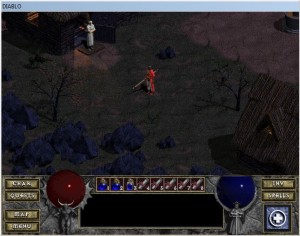 Bottom line: I was fascinated, but I love this kind of stuff. I loved it even before I became a game dev. I love hearing the behind-the-scenes stories. And it’s from my “era” – these guys were getting into game development not too much before I did. I remember that era of the industry well. It was a wild time.
Bottom line: I was fascinated, but I love this kind of stuff. I loved it even before I became a game dev. I love hearing the behind-the-scenes stories. And it’s from my “era” – these guys were getting into game development not too much before I did. I remember that era of the industry well. It was a wild time.
And… okay. I loved Diablo. Still do, but in reading the book I found the need to reinstall the game and jump through the ridiculous hoops to get it to run on a modern computer. It’s a little painful. The game is still fun, though I think it’s safe to say it has been exceeded today in most areas, although I miss its distinctively Gothic horror/fantasy feel. But at the time, some of us had spent years arguing back and forth about how you’d do a multiplayer RPG that didn’t run from a centralized server. Diablo wasn’t perfect, but it cut through the noise of arguments by actually doing it – imperfectly, but doing it. And pretty well.
It was interesting reading this book and seeing in some ways how and why Diablo appealed to me. The developers were inspired by the same roguelikes that inspired me. They felt much the same way I do, and had to make compromises that, in retrospect, were completely reasonable.
While the book may be of interest to anyone who wants to know more about the behind-the-scenes effort that goes into making a game (especially back in the 90s, or on Diablo or Warcraft specifically) , it would be of particular interest to game developers – and nearly on the level of required reading for computer RPG developers of any stripe.
Filed Under: Books, Retro - Comments: Comments are off for this article
